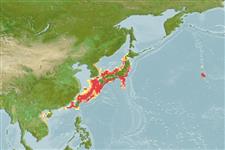Environment: milieu / climate zone / depth range / distribution range
Ecology
Marine; demersal. Temperate
Northwest Pacific: known only from the Kumanonada Sea, Japan. Described from juvenile specimen(s) and is likely to be conspecific with one of the other species in the area (Ref. 40507).
Size / Weight / Age
Maturity: Lm ? range ? - ? cm
Max length : 6.7 cm SL male/unsexed; (Ref. 559)
Life cycle and mating behavior
Maturity | Reproduction | Spawning | Eggs | Fecundity | Larvae
Masuda, H., K. Amaoka, C. Araga, T. Uyeno and T. Yoshino, 1984. The fishes of the Japanese Archipelago. Vol. 1. Tokai University Press, Tokyo, Japan. 437 p. (text). (Ref. 559)
IUCN Red List Status (Ref. 130435)
Threat to humans
Harmless
Human uses
More information
Common namesSynonymsMetabolismPredatorsEcotoxicologyReproductionMaturitySpawningSpawning aggregationFecundityEggsEgg development
Age/Size
Growth
Length-weight
Length-length
Length-frequencies
Morphometrics
Morphology
Larvae
Larval dynamics
Recruitment
Abundance
BRUVS
ReferencesAquacultureAquaculture profileStrainsGeneticsElectrophoresesHeritabilityDiseasesProcessingNutrientsMass conversion
Tools
Special reports
Download XML
Internet sources
Estimates based on models
Preferred temperature (Ref.
123201): 1 - 18.4, mean 13.3 °C (based on 67 cells).
Phylogenetic diversity index (Ref.
82804): PD
50 = 0.5002 [Uniqueness, from 0.5 = low to 2.0 = high].
Bayesian length-weight: a=0.00389 (0.00180 - 0.00842), b=3.12 (2.94 - 3.30), in cm total length, based on all LWR estimates for this body shape (Ref.
93245).
Trophic level (Ref.
69278): 3.4 ±0.5 se; based on size and trophs of closest relatives
Fishing Vulnerability (Ref.
59153): Low vulnerability (10 of 100).
